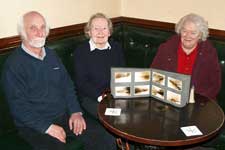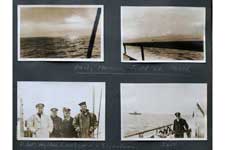Queen of Thanet
Introduction
Granton History Group was delighted to be contacted by Mrs Joan Ballantine, whose husband, Matthew Dumfries Ballantine, had served in the Royal Navy during World War II. Mrs J Ballantine showed members of the group an album of photographs that her husband had taken, and very generously offered to let the group copy it and to make the photographs available on this website and in the group’s paper archive.
Mr Ballantine was, by the end of the war, a Lieutenant Commander. The photographs were taken in 1940, 1941 and 1942 on the HMS Queen of Thanet, a minesweeper which operated from Granton in the Firth of Forth and up the east coast of Scotland including the Montrose and Aberdeen areas. Mines are explosive devices placed in the water which explode when they are triggered by ships or boats that contact them or come close to them. The job of the minesweeper was to find the mines and clear them so that shipping could use the area safely.
HMS Queen of Thanet was one of the vessels in the 7th Minesweeping Flotilla based at Granton, and forming part of the Rosyth Command. The 7th Minesweeping Flotilla consisted, at the start of 1941, of paddle minesweepers Plinlimmon, Queen of Thanet, Queen of Kent, Ryde, Sandown, Skiddaw and Westward Ho!.
The album consists of forty-seven pages of photographs, each page being titled.
We photographed each page, then divided the images to show the individual photographs. These are presented these in the order of the album, page by page.

